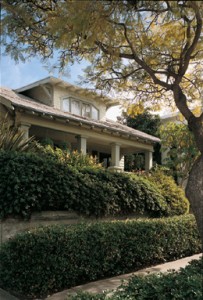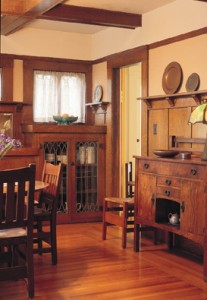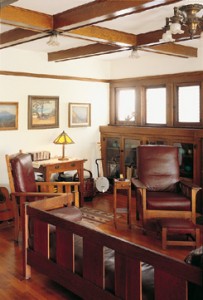Enjoying unique moments in time with family
and friends in a Craftsman home
What is it about older homes that appeals to so many of us?
Why are we willing to fix up an old dowager of a house when realistically, for about the same price, modern homes are available complete with Internet wiring and unrusted shower doors?
Owners of the old houses say they get asked this same question many times. And, in the midst of a costly repair or renovation project they often doubt their own sanity as well.
Most say they prefer older homes because there is a quality of craftsmanship and design not found in newer construction. These houses have a calmness associated with fond family memories. Bungalows and bungalow gardens are a peaceful place, a place to re-center after a crazy day at work.
And for those wishing to beat commuter times, mature neighborhoods, especially in San Diego where husband and wife Calvin Woo and Susan Merritt live, are closer to downtown.
The 1912 Craftsman bungalow they have owned since 1979 is unpretentious, yet every inch of their home is important, original and above all comfortable. It is located in San Diego’s Bankers Hill neighborhood, near the city’s famed Balboa Park. The art objects and the furniture alone surpass many collections of Americana found in museums across this country.
Calvin and Susan shrug when friends compliment them on their rare furnishings; to them it’s home and not a museum. They believe a home is to be lived in. It’s about family and how the old house ties together the generations.
“We had a wedding engagement party recently here for my daughter, Jenny Woo, and Matthew Umhofer, along with 35 friends and relatives,” said Calvin, owner of Calvin Woo Associates, one of the city’s oldest and most respected graphic design firms. “It made us feel good that she wanted to make a milestone family announcement here at our house.
Since Jenny works in Pasadena, she and Matthew have been really interested in Craftsman bungalows and recently [talked about] buying one. Her love of the genre was apparently influenced by our lifestyle. This house has a lot of nooks and crannies that all our kids enjoyed poking around and hiding in, just as I did when I grew up in my grampa’s large wooden house in Hawaii,” he says.
“The integrity of the simple design, the crafting with wood and how the home is put together impresses me,” says Susan, who is a graphic design professor at San Diego State University and has appreciated the wonderful craftsmanship found in older homes all her life.
Now empty nesters, Susan and Calvin continue to tinker with their 2,400-square-foot, two-story home. They’re busy adding a new bathroom adjacent to the upstairs master bedroom, and recently installed curtains by Diane Ayres in the downstairs public rooms.
But what has really kept their free time occupied is the organization they founded last year, Design Innovation Institute, a non-profit geared to create a dialogue between design professionals and educators at all levels with an eye to advancing design innovation.
They want to foster design education, establish scholarships and data banks, and create an all-encompassing international design museum.
Understated Elegance
One East Coast-based journalist, upon seeing the house recently, said that in all her travels she would pick this home as being “the most accurately reflective of pre-World War I bungalow living that I have seen.” Each piece has a story. Art placements are impeccable. And to repeat, they have created this impressive collection amid a working, everyday home.
 In 1982, before they started renovating the house, Susan remembers standing in the empty living room and wondering what kind of furniture they should get. (At that point they were starting from scratch and had nothing.)
In 1982, before they started renovating the house, Susan remembers standing in the empty living room and wondering what kind of furniture they should get. (At that point they were starting from scratch and had nothing.)
“Even when the house was empty we recognized its distinct personality with its built-in interior cabinets and buffet, the drawer pulls and door knobs, the fireplace and mantel, the ceiling beams and light fixtures,” says Susan.
“We didn’t know that much about the Arts and Crafts movement back then so we started researching and learning as much as we could from historians, like the late fine arts professor and craftsman author Don Covington, and groups like Save Our Heritage Organisation. We came to appreciate the Arts and Crafts design philosophy, particularly the concept of Gesamtkunstwerk (“total work of art”), and this led us to seek furniture, lamps and other household objects that would relate to each other and to the house.”
Calvin and Susan are understated about their Arts and Crafts pieces. They don’t baby their furnishings; instead, they incorporate them into their day-to-day living. That’s what they were made for, Calvin insists.
“We were lucky,” says Susan about their signed Stickley furniture. “We purchased a Limbert rocker from a gallery dealer in nearby Mission Hills, who called us one day to alert us that he was selling his inventory of Arts and Crafts furniture to raise funds to buy Roycroft originals.”
She smiles. “We certainly didn’t start out to be collectors of early-20th-century Arts and Crafts decorative pieces, but when we bought his entire collection, I guess we were locked in.” And that happened in 1988, before prices skyrocketed.
The Collection
 “We bought everything the dealer had,” Susan recalls, “about 20 pieces.” These included dining and library tables, sideboards and chairs - rocking, side- and arm- among them - all from Gustav Stickley, as well as an L. & J.G. Stickley Morris chair and a child’s armchair and rocker set.
“We bought everything the dealer had,” Susan recalls, “about 20 pieces.” These included dining and library tables, sideboards and chairs - rocking, side- and arm- among them - all from Gustav Stickley, as well as an L. & J.G. Stickley Morris chair and a child’s armchair and rocker set.
One unsigned library table had been refinished, and over the years the couple has added a set of six generic dining chairs with rush seats. They also picked up “a shaving stand we bought at an antiques fair in Del Mar, most likely handmade from a pattern — the mortise-and-tenon joints are fake,” Susan explains. Later purchases include a Gustav Stickley bed, Stickley Bros. and Wolverine library tables, an unsigned wall clock and two small smoking stands.
The couple grew to appreciate the presence of nature in the Arts and Crafts movement’s use of quartersawn oak, which reveals the energy and beauty of the wood grain. As Calvin says, “We love the innovative use of materials like the mortise-and-tenon joinery and hand-hammered copper. The furniture reveals dedicated handwork, personal attention to detail, human proportions and simplicity of design - all of which connect us to a unique moment in time.”
“We have a small collection of Van Briggle pottery and some individual pieces of Rookwood and Roseville,” says Susan, who is the archivist in the family, according to Calvin. “Our most recent pieces were found in various cities when we drove across the country recently between San Diego and Chicago, mostly along Route 66. We visited the Van Briggle pottery operation, which is still up and running in Colorado Springs.”
Of five vintage lamps they own, one is signed B. & H., another Miller, another NYWLF Co., and two others are unsigned. “We have several hand-hammered copper pieces. Some are unsigned, others are from Gustav Stickley, Roycroft and Craftsman Studios, Los Angeles. And we have a hand-hammered pewter tea set,” she adds.
“Oh,” Calvin e-mailed me when confirming details, “don’t forget to mention the engagement party, especially the excellent mariachi musicians and the deliciously prepared Mexican food and the wine from Guadalupe …”
Next time.
There are also two sons in the family. Plenty of time to have more parties at the old house.
Going With the Grain
 Calvin Woo and Susan Merritt live and work with design theory every day. Calvin points to Arts and Crafts design as a terrific example of incorporating nature into housing.
Calvin Woo and Susan Merritt live and work with design theory every day. Calvin points to Arts and Crafts design as a terrific example of incorporating nature into housing.
“Nature is like a Japanese Shinto carpenter that understood the idea of going with the grain in building Shinto shrines,” he says. “In our bungalow, there are similarities in this philosophy of going with the grain characterized by the design of Arts and Crafts architecture, furniture and accessories.”
Their non-profit Design Innovation Institute promotes design awareness through workshops, seminars, conferences and televised programs; preserves innovative artifacts and mounts exhibits; fosters experimentation between different disciplines and research on design processes and systems; and provides exploratory opportunities for children of all ages.
“Part of our goal is to demonstrate how design impacts our everyday lives and how design is influenced by nature,” says Susan.
“That could be about teaching the inherent human proportions found in the five-pointed star so often used as a basis for symbols. It also relates to how the design of surfboards is based on wave structure and conditions, and how the best tools are ergonomically designed to fit the body.”
For additional information, visit designinnovationinstitute.org.
Pin It



